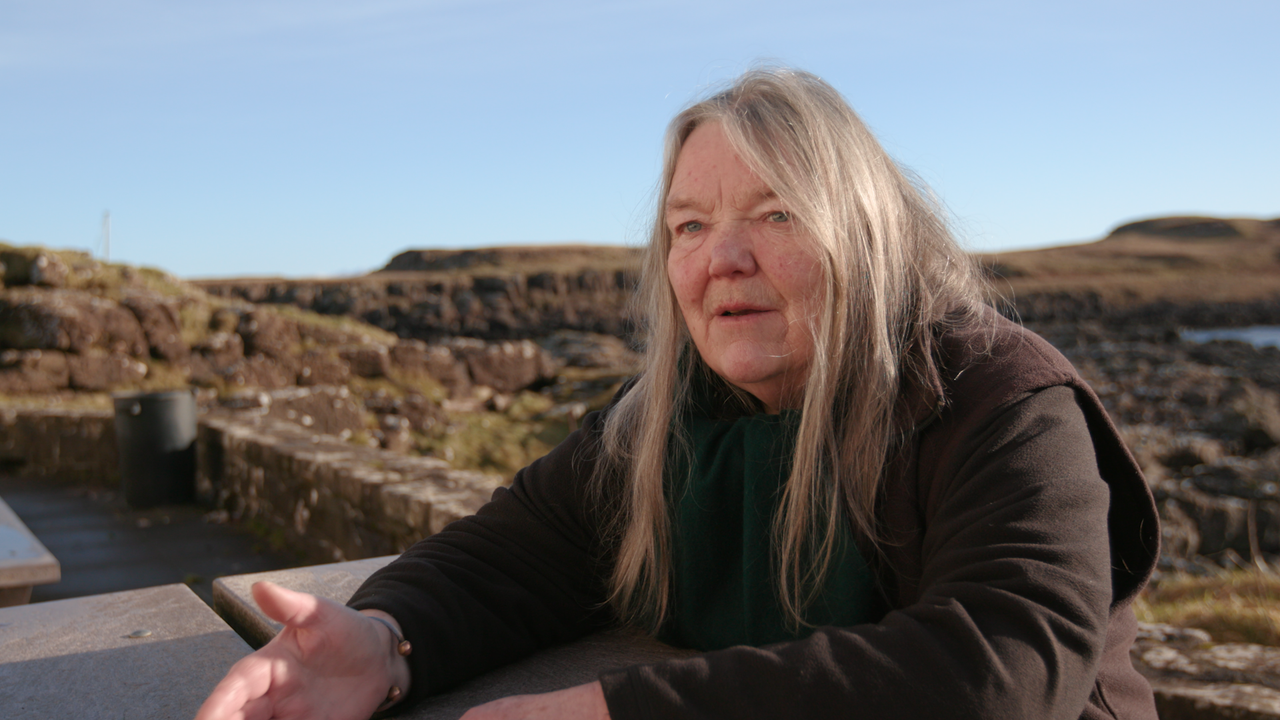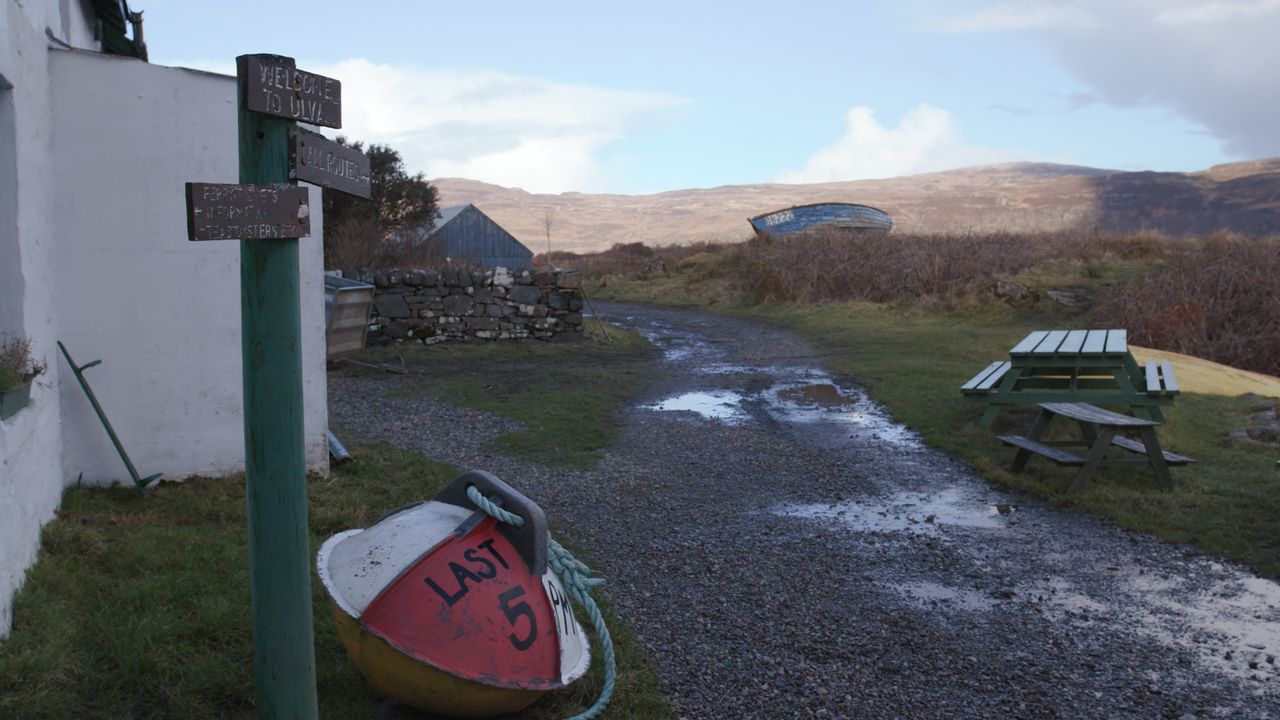Maggie Fyffe was 28 when she arrived on the Isle of Eigg, Scotland, in 1976. She came with her husband and her infant son, having been invited by the island’s owner to start a craft workshop on the island. Eigg is one of the Scottish Small Isles, an archipelago of islands a few miles off the country’s west coast, and when Fyffe arrived, the population was at an all-time low of 39.
The island was owned by businessman and former Olympic bobsleigher Keith Schellenberg. Schellenberg had bought Eigg in 1975 for the equivalent of $360,000 (274,000 pounds), and despite some initial investment, things had progressively declined. In an interview with the West Highland Free Press in 1991, he enthused that under his ownership the island had kept its “slightly rundown ... Hebridean feel.”
Fyffe and her neighbors saw it differently. “We were in extreme circumstances,” she says. “With no security of tenure, no one was investing; the community hall was falling apart; the only shop was in a corrugated shed with no water or electricity.”

Fed up and desperate for change, the community decided to do something about it. When Schellenberg’s divorce led to the island being put on the market, Eigg passed briefly to a German artist, before the newly formed Isle of Eigg Trust raised $1.97 million to buy it ― one-third from hundreds of small donations and two-thirds from a woman who has remained anonymous to this day. Last year, Eigg celebrated its 20th anniversary of community ownership.
While not the first community land purchase in Scotland, the high-profile buyout of Eigg in 1997 made headlines around the world and reignited debate and activism around land reform in the country.
Scotland has the highest concentration of private land ownership in the developed world. Just 432 landowners possess half of all Scotland’s privately owned land. Of those, two men ― the Duke of Buccleuch and Danish fashion mogul Anders Holch Povlsen ― own more than 400,000 acres, or 2 percent of the country, between them.
Vast estates and whole islands are traded between millionaires on the international property market, while those who live and work in those places are forced to watch mutely, dealing with the whims and changing fancies of one new landlord after another.
The country’s gross imbalance of land is the result of a system of feudal tenure along with antiquated inheritance laws. In the 18th century, after the end of the clan system in Scotland ― where communities of people lived together under a chief ― much of the land was parceled up and given away or taken by those who had no right to it.
Absent landlords quickly came to realize that their new acquisitions could turn more of a profit if they got rid of tenants in favor of livestock. People were cleared from land that they had known for generations in a legacy that persisted through the centuries.
But things are changing. A string of community purchases followed Eigg, facilitated by new laws introduced by the Scottish government. More than 560,000 acres of Scotland now rest in community ownership, with the government aiming to increase that figure to 1 million acres by 2020.
The Isle of Ulva, in the Inner Hebrides, which has a population of just six (down from 570 in the 1840s) is the most recent to pass out of private ownership and into the hands of the community for a total of $6.1 million earlier this year.

Those who live on community-owned land are already showing another world is possible. Since the buyout, the population of Eigg has risen to 105 and a baby is due next week. The number of visitors to the island has doubled, homes have been built, a development at the new pier houses three businesses, including a shop and a tearoom, and the island is powered almost entirely by renewables.
Fyffe, who is secretary of the Isle of Eigg Heritage Trust, acknowledges the hard work needed with democracy happening at this extremely grassroots level, and the tensions that flare up have been well-documented. But conflict is part of community, and Fyffe would not have it any other way.
Fyffe’s daughter, who had left the island along with many of her generation, has since returned because she “saw that things were happening” and because she wanted to be able to provide for her own children the sort of childhood she had known.
This story is being repeated across Scotland. Barney Higgins, 32, moved from Glasgow to the Isle of Gigha, off Scotland’s west coast, five years ago. That Gigha was community-run was a direct influence on his move, not only ideologically but for the basic fact that both his job at Achamore Gardens and the rental accommodation he lives in had been created as a result of the purchase. He is heavily involved in the life of the island, from sitting on the board of directors for the Gigha Heritage Trust, which purchased the island in 2002, to volunteering in the tearoom.

“It’s a thriving, growing, developing, challenging little place,” he told HuffPost. “I just don’t see how that could happen without that new vision that community ownership brings.”
The population growth experienced on these islands is something that many communities on the mainland would like to replicate. A 2018 report on Scotland’s sparsely populated areas found that half of the country contains just 2.6 percent of the population and that, if current trends continue, that figure will drop by almost a third by 2050.
In Sutherland, a region in the north of the Scottish mainland, for example, three-quarters of the land is in the hands of 81 families and just one person is employed for every 1,800 acres.
“What these areas need are young people, families,” according to David Cameron, a director of Community Land Scotland. “And you need jobs and housing to bring in families.”
Freeing up land from private hands, says Cameron, would bring in the homes and jobs so sorely needed. The community buyout in June 2018 of the 3,000 acre West Helmsdale crofting estate in East Sutherland has led to the creation of the first job in the area for a century, in the form of a part-time development officer, and the community says it is just the beginning.
Andy Wightman, member of the Scottish Parliament for Lothian, in the Scottish Lowlands, has dedicated much of his life to questions of land reform. He is enthusiastic about community buyouts but sees the need for them as symptomatic of still deeper structural problems.
“If our local police are not catching criminals, they don’t tell us to run the police ourselves,” he says. “So why’s our land system failing? Why had it led to this situation where the only option we have is to own this land ourselves?”
He believes, above all, that tax reforms are needed to remove the tax exemptions that large Scottish land holdings currently enjoy. That could force the land to be divided up and sold in smaller parcels that would be more economic to run, changing the current pattern of land ownership into something more widely accessible. As Cameron of Community Land Scotland puts it: “Why do people need to own so much land when they do nothing with most of it?”
Such far-reaching changes require “political bravery,” Wightman acknowledges. And yet, their ultimate aims are not as radical as they might initially appear. At the end of the 16th century, about half of Scotland was held in common ownership.
“There’s often a misapprehension that this is something new when in fact common ownership of land is a very, very old thing,” Wightman says. “We’re in effect trying to restore an older, more normal order of things, rather than creating a new order where private land ownership is the norm.”
Back on Eigg, Fyffe says she has witnessed an important shift over the past two decades. “Twenty years ago it took a long time for people to start talking about ‘we’ rather than ‘them,’” she tells HuffPost. “It was such a mindset that you had an owner, and ‘they’ were doing this or ‘they’ were doing that. It took quite a long time to become ‘we’ are doing this, ‘we’ could do that.”
For more content and to be part of the “This New World” community, follow our Facebook page.
HuffPost’s “This New World” series is funded by Partners for a New Economy and the Kendeda Fund. All content is editorially independent, with no influence or input from the foundations. If you have an idea or tip for the editorial series, send an email to thisnewworld@huffpost.com
CORRECTION: The HuffPost video at the top of this story previously misidentified John Addy.
